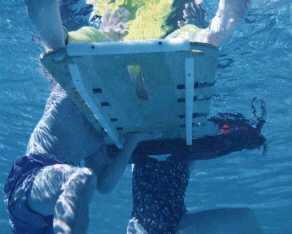Lifeguard certifications offered at De Anza College
  
 Here are descriptions of the certifications offered at De Anza College in the PE 28A class. Here are descriptions of the certifications offered at De Anza College in the PE 28A class.
The how-to-rescue certs are:
Lifeguard Training is the standard pool lifeguard certificate
Waterfront Lifeguard Training includes the standard lifeguard training and adds lake, river and non-surf beach lifeguard skills.
Shallow Water Lifeguard is for people who will supervise shallow water up to 5 feet deep. (The lifeguard and waterfront lifeguard certs also cover this material.)
Basic Water Rescue, which does not require swimming skill, was designed for public safety
personnel (police, fire, EMTs), parents, aquatic fitness instructors, aquatic therapists, child care providers, physical therapy assistants, personal fitness trainers, coaches, athletic trainers
and others who work around water but don't have the moderate swimming skills required for lifeguards. Any of these people who can swim well should try for the lifeguard cert to really add to their resume. Read more at: Basic Water Rescue.
At De Anza we offer certification in any or all of these, to be able to teach rescue skills to people with any level of swimming skill, as well as to certify lifeguards.
  
  
(The waterfront guard certification requires a trip to the beach to complete some skills that can't be done at the De Anza pool. waterfront lifeguard practice May 16, 2010)
Every type of lifeguard must also have first aid, Cardiopulmonary Resuscitation for the Professional Rescuer (CPR) and Automated External Defibrillation (AED) training.
First Aid includes recognizing emergencies, protecting yourself, prioritizing care, sudden illness, wounds, injuries to muscles, bones and joints, and heat/cold related emergencies.
CPR includes how to help someone who is choking, not breathing or has even had a heart attack. It covers all ages of victims from adults to babies.
CPR for the Professional Rescuer includes skills not taught to the general public, such as the use of specialized equipment (like a bag-valve mask to get air into a victim more efficiently) and how two rescuers can do CPR at once.

This is the most advanced CPR training available, (the same as EMTs get), and we have more time to learn it at De Anza than most lifeguard training classes.
Each student will get a separate "face" for the adult/child/infant manikins we practice on, so we don't share germs.

________________________________________________
A pocket mask
 is the device for rescue breathing with a one-way valve so your breaths go into the victim, but their escaping breath doesn't give you germs. is the device for rescue breathing with a one-way valve so your breaths go into the victim, but their escaping breath doesn't give you germs.
All lifeguards are taught how to use a pocket mask and gloves to protect themselves from germs. At De Anza we include lots more info in the entire Bloodborne Pathogens: Preventing Disease Transmission certification.
The Epinephrine Auto Injector Administration certification teaches you when, why and how to assist someone having a severe allergy attack in using their prescription.
 More and more pools are getting emergency oxygen devices to help save lives of people who have stopped breathing or are having difficulty breathing. The Administering Emergency Oxygen certification builds on what you learn in CPR and teaches you when, why and how to use the various types of devices. More and more pools are getting emergency oxygen devices to help save lives of people who have stopped breathing or are having difficulty breathing. The Administering Emergency Oxygen certification builds on what you learn in CPR and teaches you when, why and how to use the various types of devices.
The course includes automated external defibrillation training, which includes hands-on training in safely using these mini-computers to administer a lifesaving electric shock.
An automated external defibrillator (AED) is a machine that analyzes the heart's rhythm and, if necessary, tells you to deliver a shock to a victim of sudden cardiac arrest. The machine determines how much shock to deliver and talks you through the steps. It won't shock someone who doesn't need it.
We learn to use the same brand/model of AED as De Anza has at four locations on campus, but the training also applies to other models/brands.

(Relax, we've got eleven weeks.)
First Aid for Public Safety Personnel (Title 22) and Lifeguard Management are often offered outside of class time.
Do AEDs work?
A. 3 to 4%
B. 64%
C. 75%
Match the percentages above to these:
the percentage of time CPR works in television dramas
the percentage of time CPR alone without the use of an AED works
the percentage of time a typical AED system, such as the ones installed in Chicago's O'Hare Airport, is successful
the answer is at: Do AEDs work?
_____________________________________________________________
Answers to these questions:
To become a lifeguard, do I have to have a perfect freestyle?
Do I have to be a fast swimmer?
What if I have a bad knee and can't do breaststroke?
If I have the time, what can I do to get ready for class?
Doesn't a lifeguard need a lot of physical strength?
Isn't it difficult to rescue a heavy person who is sinking to the bottom of a pool?
Do lifeguards have to know how to dive?
What do students think about the De Anza lifeguard class?
Why take a lifeguard training class?
How much does lifeguard training cost?
If I don't want, or don't really have the time for a lifeguard job, can I still get experience?
What are the Red Cross certification written tests like?
When is lifeguard training offered?
Can I get the Red Cross swim teacher certification during the same quarter as the lifeguard training class?
And details about the prerequisite swim tests are at: Lifeguard Training FAQs
________________________________________

If you are in a profession that requires them (nursing, for example) Continuing Education Units (CEUs) are available after you complete this course. Go to: http://www.redcrossstore.org/dp.aspx?pgid=547
________________________________________
|

